 June 5 - August 8, 1982
|
|
| |||
Oil on canvas 53 1/2 x 39 1/2 inches (136 x 100.5 cm.) The Baltimore Museum of Art: The Mary Frick Jacobs Collection Anna Alexandrovna Galitzin (1763-1842) was the daughter of the Czarevitch of Georgia, Prince Alexander Bakarovitch Grouzinsky and his wife, Princess Daria Alexandrovna Menchikoff. Her first marriage to Alexander Alexandrovitch Litzyn (1760-1789) was childless. In 1790 she and Prince Boris Andreivitch Galitzin (1766-1822) were wed. Each partner brought to the marriage considerable wealth -at the time the Prince could claim ownership of 12,000 serfs-and their combined fortunes placed them among the most opulent members of Russia's aristocracy. "Princess Boris" was thus easily able to indulge in the luxury of having her likeness painted by the famous Frenchwoman, Mme Le Brun. And it was truly a luxury, for in 1795, Count F.V. Rostopchin could complain to Count S.R. Worontzoff, the Russian ambassador to London: "Mme Le Brun is paid a thousand, two thousand roubles for a portrait, just as one would pay two guineas in London" (cited in Hautecoeur, [19171, P. 100). Princess Galitzin gained considerable notoriety from her salon. In 1798 her husband was promoted to the rank of Lieutenant General, but under Paul I he fell from favor, and in 1800 he retired with his family to his lands at Sima in the province of Vladimir. The couple had eight children, three sons and five daughters. The dark-haired sitter is shown three-quarter length, seated in a plush and sheltered palatial environment. Her fanciful costume is part oriental, part neoclassical in conception. Over a ga ze underdress she wears a short-slee/ved brown silk peignoir shimmering with green, blue, and gold reflections. The red of the unusual plumed coiffure is repeated in the tassled sash below the bosom. The undulations of the transparent scarf accentuate the curves of the body. The rich and variegated stuffs are complemented by loose and scintillating brushwork. PROVENANCE: Elizabeth Alexievna Narychkin, as of 1905; acquired after 1917 by Wildenstein, Paris and New York; acquired in 1923 by Mary Frick Jacobs; donated in 1938 to The Baltimore Museum of Art. MAJOR EXHIBITIONS: Saint Petersburg, Taurida Palace, Artistic and Historical Exhibition of Russian Portraits, 1905, no. 247; Baltimore, Museum of Art, From El Greco to Pollock (entry byG. Levitine), October 22-December 8, 1968, no. 46, illus. SELECTED REFERENCES: Souvenirs, II, 347; Grand Duke Nicholas Mikhailovitch, 1907, IIL no. 17, illus.; Nolhac, 1908, p. 112, illus. facing p. 158; Helm, [19151, p. 198 (painting described as being signed); H.B. Jacobs, The Collection of Mary Frick Jacobs, Baltimore, 1938, no. 2, illus.;Nikolenko, 1967, pp. 93, 102-103, no. 9, illus. p. 102.
|
|
Kimbell Art Museum, Fort Worth, Texas.
Web Site Designed and Maintained by |
